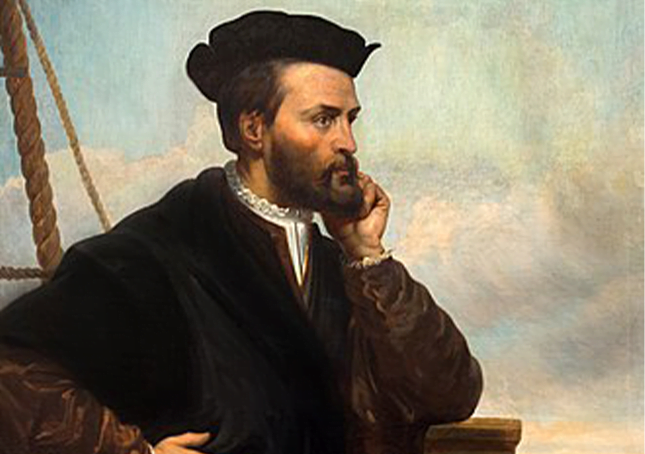Jacques Cartier

Jacques Cartier (UK: /ˈkɑːrtieɪ/ KAR-tee-ay, also US: /ˌkɑːrtiˈeɪ, kɑːrˈtjeɪ/ KAR-tee-AY, kar-TYAY,[1][2] French: [ʒak kaʁtje], Quebec French: [- kaʁt͡sje]; Breton: Jakez Karter; 31 December 1491 – 1 September 1557) was a French-Breton maritime explorer for France. Jacques Cartier was the first European to describe and map[3] the Gulf of Saint Lawrence and the shores of the Saint Lawrence River, which he named “The Country of Canadas” after the Iroquoian names for the two big settlements he saw at Stadacona (Quebec City) and at Hochelaga (Montreal Island).
Jacques Cartier was born in 1491 in Saint-Malo, the port on the north-east coast of Brittany. Cartier, who was a respectable mariner, improved his social status in 1520 by marrying Mary Catherine des Granches, member of a leading family. His good name in Saint-Malo is recognized by its frequent appearance in baptismal registers as godfather or witness.
In 1534, two years after the Duchy of Brittany was formally united with France in the Edict of Union, Cartier was introduced to King Francis I by Jean Le Veneur, bishop of Saint-Malo and abbot of Mont Saint-Michel, at the Manoir de Brion. The King had previously invited (although not formally commissioned) the Florentine explorer Giovanni da Verrazzano to explore the eastern coast of North America on behalf of France in 1524. Le Veneur cited voyages to Newfoundland and Brazil as proof of Cartier’s ability to “lead ships to the discovery of new lands in the New World”.
On April 20, 1534, Cartier set sail under a commission from the king, hoping to discover a western passage to the wealthy markets of Asia. In the words of the commission, he was to “discover certain islands and lands where it is said that a great quantity of gold and other precious things are to be found”.
It took him twenty days to sail across the ocean. Starting on May 10 of that year, he explored parts of Newfoundland, the Strait of Belle Isle and southern shore of the Labrador Peninsula, the Gaspé and North Shore coastlines on the Gulf of St. Lawrence, and some parts of the coasts of the Gulf’s main islands, including Prince Edward Island, Anticosti Island and the Magdalen Islands. During one stop at Îles aux Oiseaux (Islands of the Birds, now the Rochers-aux-Oiseaux federal bird sanctuary, northeast of Brion Island in the Magdalen Islands), his crew slaughtered around 1000 birds, most of them great auks (extinct since 1852). Cartier’s first two encounters with aboriginal peoples in Canada on the north side of Chaleur Bay, most likely the Mi’kmaq, were brief; some trading occurred.
His third encounter took place on the shores of Gaspé Bay with a party of St. Lawrence Iroquoians, where on July 24 he planted a cross to claim the land for France.[15] The 10-metre cross bearing the words “Long Live the King of France” claimed possession of the territory in the King’s name. The change in mood was a clear indication that the Iroquoians understood Cartier’s actions. Here he kidnapped the two sons of their chief, Donnacona.[16] Cartier wrote that they later told him this region where they were captured (Gaspé) was called by them Honguedo. The natives’ chief at last agreed that they could be taken, under the condition that they return with European goods to trade.
Cartier returned to France in September 1534, sure that he had reached an Asian land.
